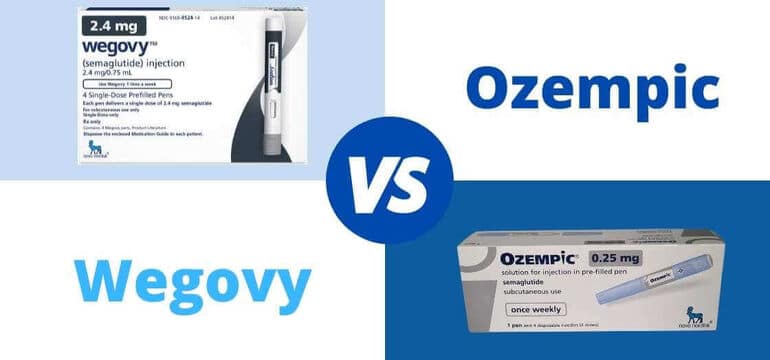Wegovy vs Ozempic
Wegovy versus Ozempic falls under the category of drugs known as glucagon-like peptide-1 (GLP-1) receptor agonists. Both medications are manufactured by Novo Nordisk and share the same active ingredient, semaglutide.
Semaglutide was originally launched as Ozempic in 2017 for the treatment of diabetes. In 2021, the same company introduced Wegovy, which contains a higher dose of semaglutide and is primarily aimed at managing overweight and obesity.
Both Wegovy and Ozempic are FDA-approved to assist in long-term weight management when combined with dietary adjustments and lifestyle changes.
These medications are suitable for individuals with a body mass index (BMI) of 30 or above. They are also beneficial for those with a BMI of 27 or higher who have additional metabolic health issues, such as type 2 diabetes or hypertension.
What Is Wegovy?
Wegovy is the first medication to receive FDA approval for chronic weight management since 2014.
The higher dosage of semaglutide in Wegovy enables better penetration of the blood-brain barrier, potentially enhancing weight loss outcomes. During the initial phase of treatment, your healthcare provider will start you on a low dose, gradually increasing it over a period of 16–20 weeks.
The starting dose for Wegovy is 0.25 mg per week, with the possibility of reaching up to 2.4 mg each week. Incrementally raising the dose can mitigate the potential side effects.
Common side effects of Wegovy include:
- Nausea and vomiting
- Diarrhea, constipation, and abdominal pain
- Headache and dizziness
- Fatigue
- Dyspepsia, abdominal distension, and eructation
- Hypoglycemia in patients with type 2 diabetes
- Flatulence, gastroenteritis, and gastroesophageal reflux disease
Severe side effects may include:
- Thyroid C-cell tumors
- Acute pancreatitis
- Acute gallbladder disease
- Acute kidney injury
- Hypersensitivity
- Diabetic retinopathy complications in patients with type 2 diabetes
- Increased heart rate
- Suicidal behavior and ideation
FDA studies have highlighted Wegovy’s effectiveness as a weight management therapy.
In one clinical trial, participants on Wegovy lost an average of 12.4% of their initial body weight, with an average BMI of 38. Another study comparing Wegovy to a placebo found that those on Wegovy experienced a 6.2% reduction in their starting weight.
The cost of Wegovy can exceed $1,500 per month without insurance. With coverage, the price may drop to as low as $25 per month. Various factors, including insurance coverage and local pharmacy pricing, can influence the overall cost.
What Is Ozempic?
Ozempic is used in combination with diet and exercise to help individuals with type 2 diabetes manage their blood sugar levels. Additionally, Ozempic reduces the risk of stroke, heart attack, or death in adults with preexisting type 2 diabetes and cardiovascular disease.
While Ozempic and Wegovy contain the same active ingredient, Ozempic has a lower dosage.
Similar to Wegovy, doctors typically begin patients on a low dose of Ozempic, 0.25 mg per week, with the option to increase by 0.25 mg every four weeks upon recommendation.
Common side effects of Ozempic include:
- Nausea
- Diarrhea
- Stomach pain
- Constipation
More severe side effects include:
- Thyroid tumors and medullary thyroid carcinoma
- Kidney problems, including kidney failure
- Pancreatic inflammation
- Severe allergic reactions
- Vision changes
- Severe hypoglycemia
Ozempic has shown efficacy in promoting weight loss when used alongside diet and exercise. It is also a proven treatment for managing type 2 diabetes.
The cost of Ozempic can vary widely based on insurance coverage. Without insurance, it may cost upwards of $800 per month, whereas covered individuals may pay as little as $25 per month.
